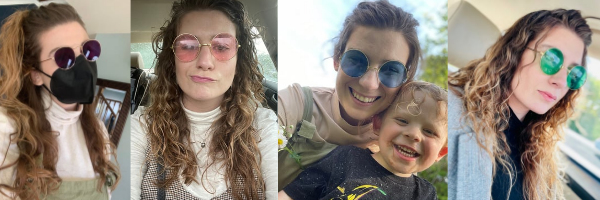Life is a colorful, delicious mosaic.
Quick: What color was your high-school science class folder?
...
🟢 Mine was green too. Pushing it a little further, English was yellow, Social Studies was blue, Math was red, and Art/Music was purple.
While you may agree or disagree with my pairings, chances are you have a strangely staunch opinion either way. And if questioned "why," it's hard to conjure a reason other than "it just is." Now imagine these strange rules extended beyond school subjects. Imagine that each color you interact with lights up a seemingly unrelated connection in your brain. Each shade and tone of the rainbow flooding a serendipitous sense. That is what it's like to experience the world through the eyes of a synesthete.
It wasn't until my sophomore year of college that I realized something is different about the way I see the world. I was sitting in an art critique; a piece of mine was in the hot seat. A fellow student questioned my color palette, specifically why all my greys were tinted green. "I just wanted it to be a little saltier," I explained, "too many of the cool blues together were nauseating." My professor corrected me, "salty isn't a shade; what was the intention behind the tone? What makes this palette feel salty?"
I wasn't sure what to say; I didn't have an intention. The truth was, painting a silver vase comprised of mildew-flavored cool grey hues was made easier by replacing the base with olive-brine seasoned mid-tones. I found myself unable to explain why these colors tasted right. I could only conjure, "It just does."
I tried to explain that looking at that much grey was the same sensation as getting an IV of saline. The salty flavor arrives on your tongue, with seemly no invitation. But even that metaphor resonated with only a portion of the room.
I began to question my friends and discovered the cause of their car-sickness wasn't the color of the road but the car's motion. I learned that they used the words "gritty," "lighter," "earthy," "chalky," and "synthetic" to describe the feeling of colors but weren't experiencing those characteristics literally. I realized that not everyone else was tasting colors.
I remember my mom trying to explain a similar experience to me as a child. We talked about our dreams from the night, and she told me about one with a red train. "It felt like the number 5," she described, "just a big, loud, 5."
We didn't have the words for it at the time, but we were both trying to explain synesthesia. "Synesthesia is a neurological condition in which information meant to stimulate one of your senses stimulates several of your senses. People who have synesthesia are called synesthetes. The word "synesthesia" comes from the Greek words: "synth" (which means "together") and "ethesia" (which means "perception)."*
As much as my friends couldn't understand how my shower curtain tasted like one of these specific root beer candies, I couldn't wrap my head around how they picked their favorite color on its look alone. How did you choose your kitchen plates if you don't have a favorite flavor plate? How do you fall asleep without the clean, minty taste of your pillowcase, extending the feeling of freshly brushed teeth? To me, they were buying Yankee candles for display purposes only. And to them, well, I guess I was eating candles, claiming they were Wonka's "Three-Course Dinner Chewing Gum."
A quick taste of these colors
I felt like I was going crazy. I just found out that my brain was broken. I felt isolated and freakish. Imagine finding out that you've been hallucinating your sense of smell your entire life, and no one shares in that world with you.
I look at the world through rose-colored glasses; and green, blue, orange, red and grey glasses. Self-medicating with multi-colored tinted shades for long drives, muting the mildew-flavored highways. Each year, I get to drink in the cherry-wine-favor and pipe-tobacco-palates of autumn.
I learned to embrace my secret superpower, realizing that it led to pleasing color palettes if I followed the flavor profiles. I applied for an internship as a color specialist for a brick manufacturer that required Superior (Good) graded color vision accuracy. I am aging myself slightly here; before color vision accuracy tests could be offered digitally, you had to complete the physical Farnsworth Munsell 100 Hue Test. Precisely as the name would suggest, the test entails arranging 100 small tiles according to slight variations in their hue. Typically, 16% of people make fewer than 16 errors on their first attempt, placing them in the Superior (Good) Score category. With my secret weapon in tow, I completed the FM 100 Hue test with 100% accuracy and secured the internship, my first position in Marketing.
Farnsworth Munsell 100 Hue Test
Taking a step beyond the professional, I learned to love the world as I experience it. When I look into my husband's eyes, I can tase the warm chai, comforting turmeric and the edge of wasabi. We painted my office walls with the flavors of crisp parchment and the brine of a bay morning—my son's hair in the sunlight creates bursts of citrus and green tea that just somehow fit him so well.
Embracing the highs of the way my brain works, means sometimes telling someone their favorite color tastes like a pool noodle (sorry purple fans), but it's so, so worth the cost. Taking a bite out of life is a lot more fun when it's full of flavor.




